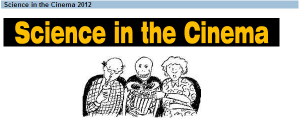The End of the ReferencePoint Blog
ReferencePoint began almost a year ago as a means of outreach to library staff to allow for sharing ideas and resources. Blog membership and participation has been lower than anticipated, therefore it lacked dialogue among the viewership. Because of this low participation and after reviewing the blog metrics, we decided to end ReferencePoint. NLM will no longer publish this blog after July 31.
Thank you to those who:
- subscribed by e-mail,
- read our RSS feed,
- gave us feedback about the blog postings, and
- remembered to stop by every week and read our postings.
Although the NLM ReferencePoint Blog is gone, you can still find out about NLM products and services through our Web site, Technical Bulletin articles, Regional Medical Libraries, our social media sites, and other the Web and social media sites of other libraries.
 July 27, 2012
July 27, 2012
 Posted in: Uncategorized
Posted in: Uncategorized  Comments Closed
Comments Closed
Movies and Health
Title: By Cynthia Burke and Ron Gordner, Reference and Web Services Section
Have you looked for new ways to present instruction to your library, healthcare staff, and students? Have you considered using movies in your presentations? Have you considered showing a movie (with group viewing rights secured, of course) and having a discussion afterwards? Well, there is a successful model: the National Institutes of Health (NIH) Science in the Cinema.
Every summer, the NIH sponsors a movie festival called “Science in the Cinema”.The festival features movies with health-related topics. While viewing movies that focus on health, I have empathized with the patient and family coping with the disorder. I also learned about diagnosis and treatment issues.
Have some fun. Do you know the condition that matches the movie?
- Lorenzo’s Oil
- A Warm December
- The Boy in the Plastic Bubble (TV movie)
- What’s Love Got to Do With It?
- John Q
- The Curious Case of Benjamin Button
- Gifted Hands: The Ben Carson Story
NLM has several film collections that you could use in your presentations. NLM Digital Collections contains two film collections: “Tropical Disease Motion Pictures” and “The Public Health Film Goes to War”. Add these short films to history of medicine presentations. Use the films to examine how diseases today were treated in the past. Has anything changed?
The “Tropical Disease Motion Pictures” include films for soldiers in tropical areas, from World War II through 2006. Examples of diseases featured include Malaria, Yellow fever, Dengue, Chagas’ disease, Cholera, and Lymphatic filariasis. Watch interviews given by internationally-known researchers on these diseases. NLM will add more films to the collection. The Public Health Film Goes to War series focuses on war-related health issues of World War II soldiers, including tropical disease prevention, personal hygiene, venereal diseases, and psychological issues.
You may recognize a famous movie star in the film about psychological issues. Who is it? I’ll post the answer next week.
To find discussion of medical and health issues portrayed in movies and television you can search PubMed.gov for articles and the NLM Catalog or LocatorPlus for books, audiovisuals, and other materials using the MeSH heading “Motion Pictures as Topic” with other terms you choose such as: medicine, physicians, nursing, psychiatry, and Hollywood.
Examples:
1. The silvering screen: old age and disability in cinema. Chivers, Sally, 1972-. Toronto: University of Toronto Press, c2011. NLM ID: 101564500 [Book]
2. Movies and mental illness: using films to understand psychopathology. Wedding, Danny; Boyd, M (Mary Ann); Niemiec, Ryan M. 3rd rev. ed. Cambridge, MA; Toronto: Hogrefe, c2010. NLM ID: 101528510 [Book]
3. Medicine’s moving pictures: medicine, health, and bodies in American film and television. Reagan, Leslie J; Tomes, Nancy, 1952-; Treichler, Paula A. Rochester, N.Y.: University of Rochester Press, 2007. NLM ID: 101303676 [Book]
4. Hollywood and women physicians. Dans, Peter E; National Library of Medicine (U.S.). Bethesda (MD): National Library of Medicine, [2005]. NLM ID: 101252951 [Videorecording]
5. Secchi C. The Sweet Hereafter by Atom Egoyan: extreme loss and psychic survival. Int J Psychoanal. 2011 Dec;92(6):1631-40. doi: 10.1111/j.1745-8315.2011.00505.x. PubMed PMID: 22212046.
6. Wellmann J. Science and cinema. Sci Context. 2011 Sep;24(3):311-28. PubMed PMID: 21995219.
7. Centers for Disease Control and Prevention (CDC). Smoking in top-grossing movies–United States, 2010. MMWR Morb Mortal Wkly Rep. 2011 Jul 15;60(27):910-3. PubMed PMID: 21753743.
To find individual films that NLM may own on a disease or health topic in LocatorPlus, use the basic search and limit to Audiovisuals. Then, add your terms. If you use the NLM Catalog, use a resource type [res type] such as motion picture or videorecording. Some of these films are also listed with the publication type: Popular Works.
Example:
Goodman, Barak; Public Broadcasting Service (U.S. The boy in the bubble [videorecording] / PBS; an Ark Media film for American experience in association with Channel 4; WGBH Boston. [Alexandria, Va.]: PBS Home Video; 2006. 1 DVD-video (60 min.):sd., col.with b&w sequences; 4 3/4 in. MeSH: Ethics, Medical; Germ-Free Life; Patient Isolators; Severe Combined Immunodeficiency* Person As Subject: Vetter, David, 1971-1984. Notes: Originally broadcast on American experience in 2005. Credits: Written by Barak Goodman; produced and directed by Barak Goodman and John Maggio. Closed-captioned. NLM ID: 101275810.
To borrow audiovisuals from NLM within the U.S. see our FAQ: Getting Materials that NLM Owns.
A non-NLM resource to identify films is the Internet Movie Database, a catalog of 1,633,300 titles and 3,649,234 names [as viewed 7/13/2012] in movies and television. You can use the advanced search feature and title text search feature for plots. You can also add a term like Asperger’s to find programs.
Answers:
- Adrenoleukodystrophy
- Sickle Cell Anemia
- Immune System Disorder
- Domestic Violence
- Health care system, organ donation
- Progeria
- Neurosurgery
QUESTION: Do you know of movies that focused on an illness or the health care provided? Did the movie help you understand a condition that you or someone you know had? Did the movie accurately portray the condition and its treatment and the patient and family’s ability to cope with it? Share your responses as comments.
Photo Credit: NIH Office of Science Education
Contact Us
We invite you to ask questions or make comment about the ReferencePoint blog or its content. Use the space at the end of each posting.
Please do not send reference questions to the ReferencePoint blog. For reference questions, visit our FAQ page and our RWS Home Page.
 July 20, 2012
July 20, 2012
 Posted in: Audiovisuals
Posted in: Audiovisuals  One Comment
One Comment
Useful Web Sites about Web Design Part 2: Federal Government Usability Sites
By Cynthia Burke, Reference & Web Services Section
The federal government has several Web sites that could help you develop and maintain usable sites. These sources are HowTo.gov and Usability.gov.
HowTo.gov has the motto, “Helping agencies deliver a great customer experience.” HowTo.gov is an official federal government site of the General Services Administrating (GSA). It covers six major areas. Web usability is one of their sub-areas. Some of the links point to examples for federal government agencies. However, you can also use the usability pages for practical step-by-step instructions on incorporating usability in your Web pages. Also, look at the “Resources and Tools” section to find more materials to make your Web site usable. Be sure to subscribe to the HowTo.gov Blog, which has many suggestions on how to build and maintain usable Web sites. Beginner, intermediate, and advanced users can benefit from HowTo.gov.
Usability.gov is a product of the U.S. Department of Health and Human Services. This Web site is similar to HowTo.gov in its content. However, this Web site covers all aspects of usability. Discover the templates, lessons learned, and how to make usable print and Web publications. Are you interested in writing position descriptions for usability staff? You can find examples on this site. Learn how to reach the mobile audience by optimizing your library Web site. The Best Practices section links to government and other Web sites. Regardless of what level you are at, Usability.gov can meet your needs. You can also get Web design and usability information from the National Library of Medicine.
Reflect on what you read on these usability sites. Read Part One of this posting. Plan based on what you read and on your users’ needs. Then act, based on guidelines, metrics, and your users’ needs.
Take Action: Subscribe to these or other usability lists. What Web design and usability Web sites do you recommend for beginners, intermediate, or advanced Web designers? How do you use these sites? Send us a link to your library’s Web site.
Photo Credit: NIST: National Institute of Standards and Technology
Contact Us
We invite you to ask questions or make a comment about the ReferencePoint blog or its content. Use the space at the end of each posting.
Please do not send reference questions to the ReferencePoint blog. For reference questions, visit our FAQ page and our RWS Home Page.
 July 12, 2012
July 12, 2012
 Tags: usability, Web design Posted in: Usability
Tags: usability, Web design Posted in: Usability  Comments Closed
Comments Closed




